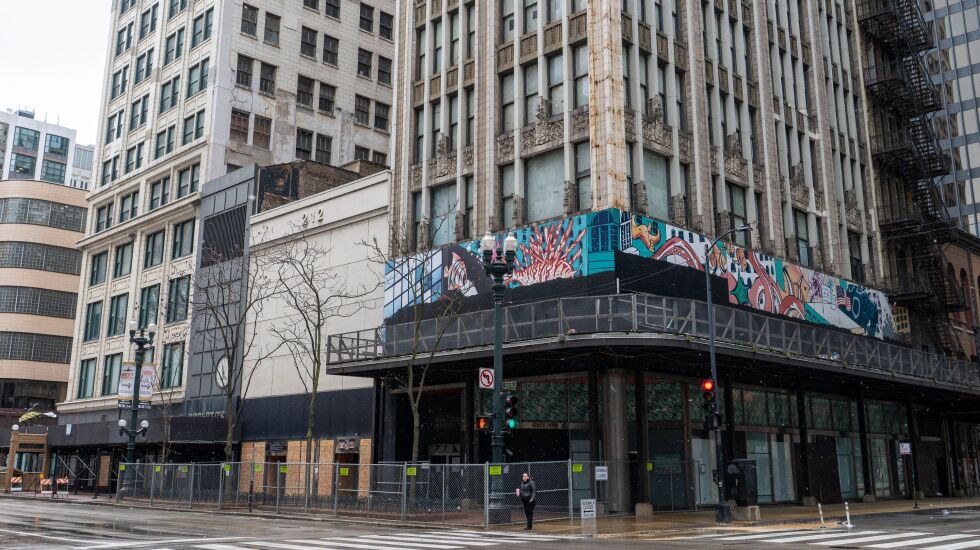
The federal government has closed the sidewalk in front of buildings it owns at the southwest corner of State and Adams streets, citing a threat to pedestrians from deteriorating facades. The property includes two early 20th century skyscrapers that preservationists want to save.
Fences were put up at the site days after the group Preservation Chicago last week put the buildings at 202 and 220 S. State St. on its “most endangered” list for 2023. The group is opposing the federal government’s plan to level the site as a security risk. The structures back up against the Dirksen Federal Building.
The General Services Administration, which manages federal property, acted after a contractor warned of danger to pedestrians, agency spokesperson Tanya Schusler said. She said the façade concerns mostly involve a three-story building at 208-212 S. State, one of two small buildings between the 202 and 220 high-rises. The buildings are vacant.
The federal government has appropriated $52 million to demolish the buildings. But it can’t act unilaterally because the buildings are listed with the National Register of Historic Places.
The GSA, following federal law, has been holding hearings to consider alternatives to demolition. The federal government has owned the buildings since 2005. Scaffolds have been in front of the buildings for years, but only now has pedestrian access been cut off.
Asked what the agency will do next, Schusler said, “Once we receive recommendations from our contracted engineers, we will work within the National Historic Preservation Act, Section 106, consultation process to confirm how GSA will execute additional remedies.” She said the city’s Transportation Department issued a permit for the sidewalk closure.
Ward Miller, executive director of Preservation Chicago, said the closure reflects poorly on the GSA.
“They just haven’t been the best stewards of these structures. It seems like demolition by neglect,” he said.
A campaign to save at least the taller buildings has garnered support from the downtown business group Chicago Loop Alliance. A petition calling for their preservation has gotten more than 23,000 signatures at Change.org.
Miller’s group has backing from 20 religious organizations and from Dominican University in River Forest to operate the buildings as a cooperative archives center. He said that type of use could bring limited public access and allay the worries about security for federal courts.
Last week, the U.S. District Court said it was aware of the façade issues. In a statement from the court, Chief Judge Rebecca R. Pallmeyer said, “The safety of the public is of utmost importance to me. I have requested that the GSA keep me informed of their ongoing assessment of the property.”
During a July hearing of the Commission on Chicago Landmarks, Pallmeyer said the buildings should be torn down.
“We recognize, again, that this is an issue that draws a lot of attention, but we think there really are benefits to a proposal that would eliminate those buildings, particularly for State Street,” Pallmeyer said. She said the buildings have made their block of State “somewhat moribund” and that removing them would allow improved pedestrian access to the Dirksen building from the east.
The landmarks panel in July directed city staff to prepare a report on the buildings’ historic and architectural merits. It has taken no action since then on naming the taller buildings Chicago landmarks.
The taller terra cotta buildings point to the evolution of early skyscrapers. Holabird & Roche designed the 16-story Century Building at 202 S. State. Jenney, Mundie & Jensen designed the 21-story Consumers Building at 220 S. State.
The smaller buildings between them, though significantly altered, also are more than a century old. GSA records show the 208-212 building dates from 1920, and the four-story building at 214 was built in 1887.







